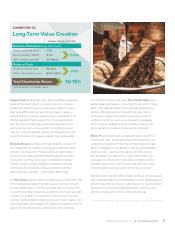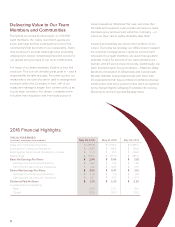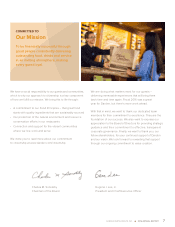Red Lobster 2016 Annual Report Download - page 19
Download and view the complete annual report
Please find page 19 of the 2016 Red Lobster annual report below. You can navigate through the pages in the report by either clicking on the pages listed below, or by using the keyword search tool below to find specific information within the annual report.
MANAGEMENT’S DISCUSSION AND ANALYSIS
OF FINANCIAL CONDITION AND RESULTS OF OPERATIONS
DARDEN
DARDEN RESTAURANTS, INC. • 2016 ANNUAL REPORT 15
EARNINGS FROM DISCONTINUED OPERATIONS
On an after-tax basis, earnings from discontinued operations for fiscal 2016
were $15.3 million ($0.12 per diluted share) compared with earnings from
discontinued operations for fiscal 2015 of $513.1 million ($3.96 per diluted
share) and fiscal 2014 of $103.0 million ($0.77 per diluted share). Earnings
from discontinued operations reflects pre-tax gains of $17.9 million recorded
in fiscal 2016 and $837.0 million in fiscal 2015, related to the sale of
Red Lobster.
SEGMENT RESULTS
We manage our restaurant brands, Olive Garden, LongHorn Steakhouse,
The Capital Grille, Yard House, Bahama Breeze, Seasons 52 and Eddie V’s
in North America as operating segments. We aggregate our operating
segments into reportable segments based on a combination of the size,
economic characteristics and sub-segment of full-service dining within
which each brand operates. Our four reportable segments are: (1) Olive
Garden, (2) LongHorn Steakhouse, (3) Fine Dining and (4) Other Business
(see Note 6 to our consolidated financial statements).
Our management uses segment profit as the measure for assessing
performance of our segments. Olive Garden’s segment profit margins were
19.8 percent for fiscal 2016, 18.5 percent for fiscal 2015 and 17.8 percent
for fiscal 2014. The growth for fiscal 2016 was driven primarily by leverag-
ing positive same-restaurant sales, food and beverage cost favorability and
cost reduction initiatives, partially offset by additional rent expense resulting
from real estate transactions. The growth for fiscal 2015 was driven
primarily by leveraging positive same-restaurant sales and cost reduction
initiatives, partially offset by food and beverage cost inflation. LongHorn’s
segment profit margins were 17.3 percent for fiscal 2016, 15.5 percent for
fiscal 2015 and 14.8 percent for fiscal 2014. The growth for fiscal 2016
was driven primarily by leveraging positive same-restaurant sales as well
as improved cost of sales and lower marketing expense, partially offset by
additional rent expense resulting from real estate transactions. The growth
for fiscal 2015 was driven primarily by leveraging positive same-restaurant
sales and cost reduction initiatives, partially offset by food and beverage
cost inflation. Fine Dining’s segment profit margins were 19.5 percent for
fiscal 2016, 19.0 percent for fiscal 2015 and 18.4 percent for fiscal 2014.
The growth for fiscal 2016 was driven primarily by improved food and
beverage costs. The growth for fiscal 2015 was driven primarily by leveraging
positive same-restaurant sales and lower restaurant expenses. The Other
Business segment profit margins were 16.9 percent for fiscal 2016,
15.5 percent for fiscal 2015 and 13.4 percent for fiscal 2014. The growth
for fiscal 2016 was driven by positive same-restaurant sales leverage and
lower food and beverage costs. The growth for fiscal 2015 was driven by
positive same-restaurant sales leverage and lower restaurant expenses.
SEASONALITY
Our sales volumes fluctuate seasonally. Typically, our average sales per
restaurant are highest in the winter and spring, followed by the summer, and
lowest in the fall. Holidays, changes in the economy, severe weather and
similar conditions may impact sales volumes seasonally in some operating
regions. Because of the seasonality of our business, results for any quarter
are not necessarily indicative of the results that may be achieved for the full
fiscal year.
IMPACT OF INFLATION
We attempt to minimize the annual effects of inflation through appropriate
planning, operating practices and menu price increases. We do not believe
inflation had a significant overall effect on our annual results of operations
during fiscal 2016. We experienced higher than normal inflationary costs
during fiscal 2015 and fiscal 2014 and were able to partially reduce the
annual impact utilizing these strategies.
CRITICAL ACCOUNTING ESTIMATES
We prepare our consolidated financial statements in conformity with U.S.
generally accepted accounting principles. The preparation of these financial
statements requires us to make estimates and assumptions that affect the
reported amounts of assets and liabilities and disclosure of contingent
assets and liabilities at the date of the financial statements and the reported
amounts of sales and expenses during the reporting period. Actual results
could differ from those estimates.
Our significant accounting policies are more fully described in Note 1
to the consolidated financial statements. Judgments and uncertainties
affecting the application of those policies may result in materially different
amounts being reported under different conditions or using different
assumptions. We consider the following estimates to be most critical in
understanding the judgments that are involved in preparing our consolidated
financial statements.
Leases
We evaluate our leases at their inception to estimate their expected term,
which commences on the date when we have the right to control the use
of the leased property and includes the non-cancelable base term plus all
option periods we are reasonably assured to exercise. Our judgment in
determining the appropriate expected term for each lease affects our
evaluation of:
• The classification and accounting for leases as capital
versus operating;
• The rent holidays and escalation in payments that are included in the
calculation of straight-line rent; and
• The term over which leasehold improvements for each restaurant
facility are amortized.
These judgments may produce materially different amounts of
depreciation, amortization and rent expense than would be reported if
different expected lease terms were used.
Valuation of Long-Lived Assets
Land, buildings and equipment and certain other assets, including
definite-lived intangible assets, are reviewed for impairment whenever
events or changes in circumstances indicate that the carrying amount
of an asset may not be recoverable. The judgments we make related to the
expected useful lives of long-lived assets, definitions of lease terms and our
ability to realize undiscounted cash flows in excess of the carrying amounts
of these assets are affected by factors such as the ongoing maintenance and
improvements of the assets, changes in economic conditions, changes in
usage or operating performance, desirability of the restaurant sites and other
factors, such as our ability to sell our assets held for sale. As we assess the
ongoing expected cash flows and carrying amounts of our long-lived assets,
significant adverse changes in these factors could cause us to realize an
























